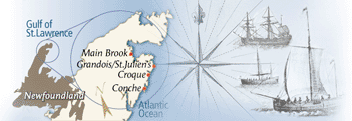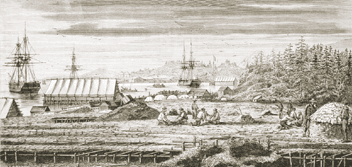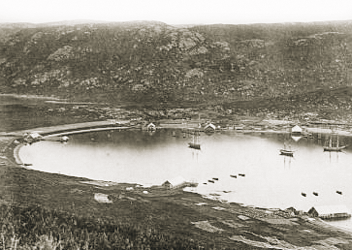|
Conche, Croque, Grandois/St. Julien's and Main Brook are located along a stretch of coastline known as the French Shore. In the early 1500s, European fishing crews of many nations began sailing across the North Atlantic for great stocks of cod reported by John Cabot.

By the 17th century, the Newfoundland cod fishery had become a significant part of the European economy and politics. English and French fleets soon dominated the fishery. Their struggle for control of the Newfoundland fishery played a continuing role in the European wars and treaties between 1689 and 1815. When the French lost control of Newfoundland in 1713, they negotiated the exclusive right to fish cod seasonally in designated Newfoundland waters referred to in treaties as the French Shore. These treaty rights remained until 1904.

|
The French cod fishermen, most of whom came from Brittany and Normandy, only stayed in Newfoundland for the summer. Each year in early spring, French ships would arrive in Newfoundland, set up temporary bases to catch and dry cod, and sail back to Europe in the fall, their ships loaded with salt fish.
In the 1800s, while France was preoccupied with Napoleon's wars, Newfoundland settlers moved up the east coast within the boundaries of the French Shore. French captains began hiring settlers as caretakers or "guardians" to protect their fishing gear in the winter while they were back in France.

While no French have fished in our harbours for more than a century, there are signs of their presence everywhere. Along the shoreline trails they built, we have found the remains of bread ovens, pebble beaches for drying cod, and other traces of their daily routine on the French Shore. The French Shore Historical Society invites you to discover these intriguing vestiges of the French fishery, scattered throughout our 4 communities.
|